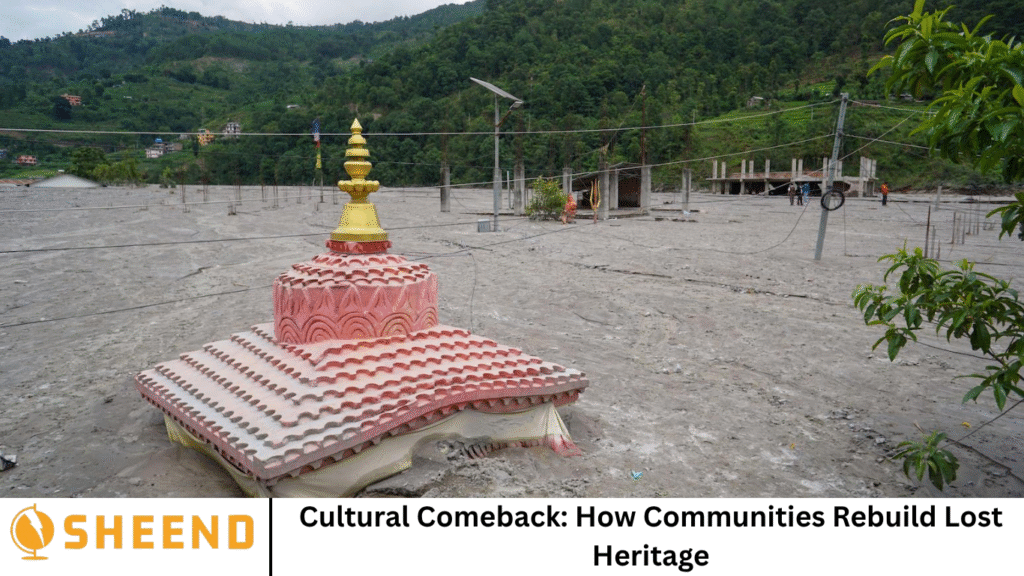Across the globe, countless communities have witnessed the erosion or outright loss of their cultural heritage due to colonization, war, forced migration, globalization, and systemic erasure. What was once a vibrant tapestry of language, rituals, music, and customs may now exist only in fragments.
Communities, large and small, are fighting to reclaim what was lost. From reviving endangered languages to restoring sacred lands and traditional knowledge, people are piecing together their identities with both pride and perseverance. But there is a powerful movement underway—a cultural comeback.
This article explores how communities are rebuilding their lost heritage through grassroots movements, educational initiatives, arts and storytelling, and legal battles for recognition and restitution. Culture is the heartbeat of a community—woven through its stories, songs, languages, ceremonies, and everyday practices.
More Read: Cooking Up Memories: Where Food and Family History Meet
Understanding Cultural Loss: What’s at Stake
Cultural heritage is more than just relics or songs—it’s the soul of a community. It includes:
- Tangible heritage: monuments, artifacts, clothing, architecture
- Intangible heritage: language, traditions, rituals, oral histories
- Natural heritage: sacred landscapes, rivers, and ecological knowledge
When this heritage is lost, communities lose not only their history but their sense of identity, belonging, and continuity. This often results in generational trauma and cultural displacement.
Key causes of cultural loss include:
- Colonization and forced assimilation
- War and displacement
- Economic globalization and urbanization
Climate change and environmental destruction
But in response, communities have initiated a powerful movement of cultural revival.
Language Revitalization: Breathing Life into Words
Language is a foundational pillar of any culture. When a language dies, a unique way of understanding the world dies with it. According to UNESCO, over 40% of the world’s estimated 7,000 languages are at risk of extinction. However, several communities are leading language revival efforts:
Case Study: Māori Language in New Zealand
The Māori language (Te Reo Māori) was once on the brink of extinction due to British colonization. Today, it is experiencing a resurgence:
- Kōhanga Reo (language nests): immersion preschools for toddlers
- Te Wiki o te Reo Māori: Māori Language Week, celebrated nationwide
- Media and arts: TV shows, songs, and podcasts in Māori
Through persistent activism, Māori leaders have secured government support, ensuring language is taught in schools and spoken proudly in public life.
Reclaiming Traditional Practices and Rituals
Rituals, music, food, and crafts all embody the values and experiences of a culture. Many indigenous communities are reviving their traditional practices to reconnect with their roots.
Examples:
- The Sami of Scandinavia have reintroduced the use of traditional clothing (Gákti) and reindeer herding rituals.
- African-American communities are rediscovering ancestral spiritual traditions like Yoruba and Gullah practices.
- Peruvian Andean communities continue to revive Inti Raymi, a festival honoring the sun god.
Workshops, festivals, and local cultural centers play a vital role in keeping these traditions alive and adapting them for new generations.
Intergenerational Storytelling: Passing Wisdom Across Time
One of the most powerful tools in cultural restoration is storytelling. Oral histories pass down myths, survival skills, morals, and family lineages.
Revival through media and technology:
- Digital storytelling platforms such as StoryCorps and YouTube preserve personal narratives and ancestral tales.
- Podcasts and documentaries amplify voices from marginalized communities.
- Virtual museums offer immersive cultural education.
Storytelling strengthens family bonds, affirms collective identity, and helps younger generations understand where they come from.
Art and Music as Cultural Anchors
Art, music, and dance are universal forms of cultural expression. Reviving traditional artistic forms empowers communities to assert their identity and resist cultural homogenization.
Examples of Artistic Revivals:
- Native American tribes incorporating traditional drumming and regalia into contemporary music.
- Cuban communities reintroducing Afro-Cuban rhythms and Santería songs.
- Pakistani communities reviving truck art and Sufi poetry as symbols of resistance and pride.
Cultural festivals, performances, and artist grants allow these practices to thrive while engaging broader audiences.
Legal and Political Advocacy: Fighting for Recognition
Rebuilding lost heritage often requires confronting legal systems and demanding restitution. Communities seek recognition, land rights, and reparations for cultural theft.
High-impact movements include:
- The repatriation of stolen artifacts from Western museums to their countries of origin.
- The fight for land back initiatives among indigenous groups in North America and Australia.
- Cultural heritage protections under international conventions like UNESCO’s 2003 Convention for the Safeguarding of Intangible Cultural Heritage.
In 2021, France returned 26 artifacts looted during colonial rule to Benin. Such milestones represent more than symbolic victories—they affirm a people’s right to their history.
Education as a Catalyst for Cultural Recovery
Education systems have long played a role in erasing indigenous and minority cultures. Today, many communities are flipping the script by establishing their own schools and curricula.
Initiatives Include:
- Language immersion schools like Hawaiian Pūnana Leo
- Tribal colleges and universities teaching indigenous history and epistemology
- Cultural literacy programs in public schools with inclusive textbooks
By putting culture at the center of education, communities ensure that future generations grow up proud of who they are.
Technology and the Digital Archive Revolution
Modern technology is a double-edged sword. While globalization threatens cultural diversity, tech also provides tools to preserve and spread heritage in powerful ways.
Digital Cultural Preservation:
- Virtual heritage projects like CyArk and Google Arts & Culture digitize ancient sites.
- AI language tools help catalog and teach endangered languages.
- Blockchain and NFTs offer new ways to register cultural artifacts and protect indigenous copyrights.
This democratization of cultural tools allows small communities to create global impact with limited resources.
Healing Through Cultural Reclamation
- Cultural loss is often intertwined with historical trauma, particularly for colonized and displaced peoples. Reclaiming heritage is not only about memory—it’s about healing.
- Restoring pride in one’s roots helps combat feelings of shame, inferiority, and cultural amnesia. It also strengthens mental health, self-esteem, and community cohesion.
- Therapists, social workers, and community leaders are now incorporating cultural practices into mental wellness approaches, recognizing their profound psychological importance.
The Role of Youth in Cultural Revivals
Young people are at the heart of cultural comebacks. Far from being disinterested, they are reclaiming their heritage with fresh perspectives.
Examples:
- Youth-led TikTok accounts teaching native languages
- Indigenous influencers promoting traditional fashion and identity
- Students forming clubs to revive forgotten holidays and customs
Empowered youth are reimagining culture not as a relic of the past, but as a living, evolving force.
Frequently Asked Question
What causes cultural heritage to be lost in the first place?
Cultural loss can occur due to colonization, war, forced assimilation, globalization, migration, environmental change, and the loss of elders. These forces disrupt the transmission of traditions, languages, and rituals.
Can a culture be fully restored after being suppressed or forgotten?
While not every element can be recovered, many aspects can be revived or reinterpreted. Cultural revival is about adaptation as much as preservation, and new generations often blend traditional and modern expressions.
What role do governments play in cultural restoration?
Governments can either hinder or help cultural revivals. Supportive policies include funding cultural programs, including indigenous history in education, returning stolen artifacts, and recognizing cultural rights legally.
How can I support a community’s cultural comeback?
You can support by donating to cultural preservation initiatives, attending cultural events, advocating for inclusive education, and amplifying voices from historically marginalized groups.
What is the importance of language in cultural heritage?
Language encodes a community’s worldview, humor, spiritual beliefs, and social structure. Reviving a language helps restore pride, identity, and intergenerational communication.
Are there global organizations supporting cultural heritage preservation?
Yes. UNESCO, The Smithsonian Institution, Cultural Survival, and various NGOs work globally to protect and revive cultural traditions and heritage sites.
Is it cultural appropriation to participate in another group’s cultural revival efforts?
Support is welcomed when done respectfully and in partnership with the community. Listening, learning, and following their lead is key. Avoid co-opting or profiting from traditions without permission.
Conclusion
While it’s true that some traditions may fade or transform, culture is incredibly resilient. Communities around the world are proving that heritage can be revived, even after decades of silence or suppression. Through language, rituals, art, education, and advocacy, these efforts form a tapestry of resistance, pride, and hope. The cultural comeback is not just about the past—it’s about shaping the future. When communities reclaim their lost heritage, they do more than remember—they rise.


